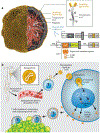Biomaterials for in situ cell therapy
- PMID: 39574564
- PMCID: PMC11581612
- DOI: 10.1002/bmm2.12039
Biomaterials for in situ cell therapy
Abstract
Cell therapy has revolutionized the treatment of various diseases, such as cancers, genetic disorders, and autoimmune diseases. Currently, most cell therapy products rely on ex vivo cell engineering, which requires sophisticated manufacturing processes and poses safety concerns. The implementation of in situ cell therapy holds the potential to overcome the current limitations of cell therapy and provides a broad range of applications and clinical feasibility in the future. A variety of biomaterials have been developed to improve the function and target delivery to specific cell types due to their excellent biocompatibility, tunable properties, and other functionalities, which provide a reliable method to achieve in vivo modulation of cell reprogramming. In this article, we summarize recent advances in biomaterials for in situ cell therapy including T cells, macrophages, dendritic cells, and stem cells reprogramming leveraging lipid nanoparticles, polymers, inorganic materials, and other biomaterials. Finally, we discuss the current challenges and future perspectives of biomaterials for in situ cell therapy.
Keywords: biomaterial; cell therapy; drug delivery; in situ.
Conflict of interest statement
CONFLICT OF INTEREST STATEMENT Yizhou Dong is a scientific advisory board member of Arbor Biotechnologies. The other authors declare no conflicts of interest.
Figures





Similar articles
-
Biomaterials for chimeric antigen receptor T cell engineering.Acta Biomater. 2023 Aug;166:1-13. doi: 10.1016/j.actbio.2023.04.043. Epub 2023 May 2. Acta Biomater. 2023. PMID: 37137403 Review.
-
Engineering and Functionalization of Gelatin Biomaterials: From Cell Culture to Medical Applications.Tissue Eng Part B Rev. 2020 Apr;26(2):164-180. doi: 10.1089/ten.TEB.2019.0256. Epub 2020 Feb 4. Tissue Eng Part B Rev. 2020. PMID: 31910095 Review.
-
Engineering Biomaterials with Micro/Nanotechnologies for Cell Reprogramming.ACS Nano. 2020 Feb 25;14(2):1296-1318. doi: 10.1021/acsnano.9b04837. Epub 2020 Feb 3. ACS Nano. 2020. PMID: 32011856 Free PMC article. Review.
-
Recent advances in biomaterial-boosted adoptive cell therapy.Chem Soc Rev. 2022 Mar 7;51(5):1766-1794. doi: 10.1039/d1cs00786f. Chem Soc Rev. 2022. PMID: 35170589 Review.
-
Polydopamine-Based Biomaterials in Orthopedic Therapeutics: Properties, Applications, and Future Perspectives.Drug Des Devel Ther. 2024 Aug 26;18:3765-3790. doi: 10.2147/DDDT.S473007. eCollection 2024. Drug Des Devel Ther. 2024. PMID: 39219693 Free PMC article. Review.
Cited by
-
Engineering exosome membrane disguised thermal responsive system for targeted drug delivery and controlled release across the blood-brain barrier.Mater Today Bio. 2025 Mar 11;32:101656. doi: 10.1016/j.mtbio.2025.101656. eCollection 2025 Jun. Mater Today Bio. 2025. PMID: 40160247 Free PMC article.
-
A Review on the Stability Challenges of Advanced Biologic Therapeutics.Pharmaceutics. 2025 Apr 23;17(5):550. doi: 10.3390/pharmaceutics17050550. Pharmaceutics. 2025. PMID: 40430843 Free PMC article. Review.
-
A microenvironment responsive nanoparticle regulating osteoclast fate to promote bone repair in osteomyelitis.Mater Today Bio. 2025 Apr 17;32:101777. doi: 10.1016/j.mtbio.2025.101777. eCollection 2025 Jun. Mater Today Bio. 2025. PMID: 40321696 Free PMC article.
-
Natural Nano-Minerals (NNMs): Conception, Classification and Their Biomedical Composites.ACS Omega. 2024 Apr 8;9(16):17760-17783. doi: 10.1021/acsomega.4c00674. eCollection 2024 Apr 23. ACS Omega. 2024. PMID: 38680370 Free PMC article. Review.
-
AI-driven 3D bioprinting for regenerative medicine: From bench to bedside.Bioact Mater. 2024 Nov 23;45:201-230. doi: 10.1016/j.bioactmat.2024.11.021. eCollection 2025 Mar. Bioact Mater. 2024. PMID: 39651398 Free PMC article. Review.
References
-
- Roth TL, Puig-Saus C, Yu R, Shifrut E, Carnevale J, Li PJ, Hiatt J, Saco J, Krystofinski P, Li H, Tobin V, Nguyen DN, Lee MR, Putnam AL, Ferris AL, Chen JW, Schickel J-N, Pellerin L, Carmody D, Alkorta-Aranburu G, del Gaudio D, Matsumoto H, Morell M, Mao Y, Cho M, Quadros RM, Gurumurthy CB, Smith B, Haugwitz M, Hughes SH, Weissman JS, Schumann K, Esensten JH, May AP, Ashworth A, Kupfer GM, Greeley SAW, Bacchetta R, Meffre E, Roncarolo MG, Romberg N, Herold KC, Ribas A, Leonetti MD, Marson A, Nature 2018, 559, 405. - PMC - PubMed
-
- Liu E, Marin D, Banerjee P, Macapinlac HA, Thompson P, Basar R, Nassif Kerbauy L, Overman B, Thall P, Kaplan M, Nandivada V, Kaur I, Nunez Cortes A, Cao K, Daher M, Hosing C, Cohen EN, Kebriaei P, Mehta R, Neelapu S, Nieto Y, Wang M, Wierda W, Keating M, Champlin R, Shpall EJ, Rezvani K, N. Engl. J. Med 2020, 382, 545. - PMC - PubMed
Grants and funding
LinkOut - more resources
Full Text Sources
